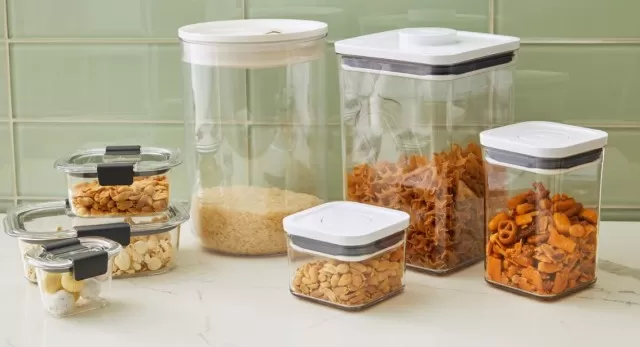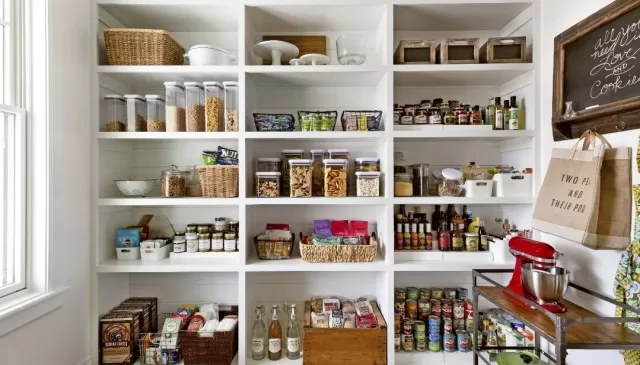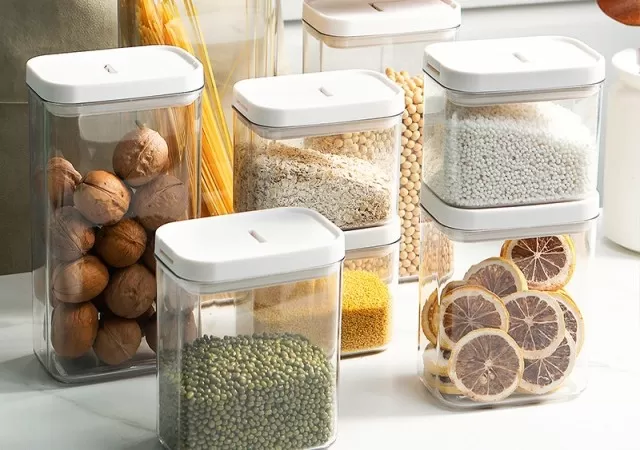Simplify the process of locating items in your kitchen with these innovative food storage solutions.
These clever ideas for organizing your pantry, kitchen cabinets, and freezer will ensure that you have a clear understanding of what’s available in your kitchen.
This, in turn, will make meal preparation a stress-free experience and simplify your grocery shopping routine.
Food Storage Methods

A Suitable Storage Solution.
Having stale cereal and squashed granola bars for breakfast can be pretty disappointing.
To ensure your morning essentials stay fresh, it’s essential to have storage options that are tailored to your needs. You can arrange granola bars neatly in baskets, while cereals, marshmallows, cookies, and other items that require a tight seal for freshness can be stored in lidded plastic containers.
Extra Storage Options.
If you’re looking to maximize your kitchen’s storage space, consider using unfitted storage units.
For instance, a sturdy metal shelving unit placed next to your refrigerator can be equipped with baskets to hold baking supplies and bottled drinks.
Creating a Pantry Alternative.
Don’t have a designated pantry area? No Problem! You can designate a niche next to your refrigerator as your food staple central.
Install shelves (a bookcase can work well) and hang a tension curtain rod between the wall and the refrigerator. Add a curtain that matches your kitchen decor to create a visually appealing pantry-like space.
Understanding Your Storage Space.
When purchasing storage containers for baking supplies, it’s important to consider the dimensions and configuration of your shelves.
If the containers are too tall, they won’t fit, and if they’re too small, you won’t be able to store as much. Grouping containers of similar sizes can help you make the most of your available space.
Additionally, labeling the containers clearly will prevent any ingredient mix-ups.
Convenient Slide-out Options.
If you’re renovating your kitchen cabinets, think about incorporating slide-out baskets.
These are perfect for storing vegetables like onions and potatoes that don’t require refrigeration. If you’re not planning to change your existing cabinets, you can still add this feature by simply removing a cabinet door and installing the necessary hardware.
Optimizing Shallow Spaces.
While deep pantries can hold more items, a shallow pantry ensures that everything remains easily accessible.
To make efficient use of shallow space, organize your goods by type so that everything is within reach. It’s also important to prioritize your purchases to avoid accumulating unnecessary surplus.
Store any extras in a lower-traffic area and maintain a list of backstock ingredients on your pantry door.

Slide-out Pantry Convenience.
Never lose sight of another food staple hidden in the depths of your cabinets.
A slide-out cabinet with shelves provides an organized solution for cereals, cooking essentials, and snacks. A simple pull of the handle brings everything into view.
Moreover, the front panel of the slide-out pantry can be designed to match the surrounding cabinetry, maintaining a consistent look while adding functional benefits.
A Spice-Savvy Approach.
Make use of unused wall space by installing a wall-mounted spice rack to hold jars of spices.
With your cooking staples prominently displayed, you’ll always know what you have on hand and what needs to be added to your grocery list.
Fresh Bread Preservation.
An old-fashioned bread drawer with a ventilated lid ensures that your loaves stay fresh and provides a convenient storage spot.
If you don’t have cabinet storage space for a bread drawer, consider a retro-inspired breadbox instead. It serves the same purpose while saving valuable kitchen cabinet space.
Realizing Storage Potential.
Spices and herbs may come in small packages, but they play a significant role in cooking.
Keep them readily accessible for any culinary adventure with a Smart Storage solution like a spice rack mounted on the inside of a cabinet door. The guard rails on the rack prevent containers from sliding around, and having the unit on the door frees up space inside the cabinet.
Efficient and Practical Storage.
Sometimes, the original packaging of certain products is not suitable for long-term storage.
Replace flimsy cardboard boxes and non-resealable bags in your pantry with a streamlined system. Transfer the ingredients to airtight storage canisters and cut out vital information from the packages, such as nutrition details and instructions.
Attach the cut-outs to the plastic containers. Make sure to locate the expiration dates and write them on the labels.
Closet-Inspired Organization.
Consider implementing a modular system, similar to what you would find in a clothing closet, for your pantry.
Shelves designed for shoes, purses, and folded sweaters are equally effective in storing bottled drinks and pantry extras. You can even outfit a section of the system with a wine rack to store your collection.

Effective Labeling.
When storing containers in a drawer, it can be challenging to see what’s inside each one.
Eliminate the guesswork by using lid labels. Attach the vinyl paper to the jar lids and use a dry-erase marker to label the contents of each jar.
Embracing Jar Storage.
Store frequently used kitchen staples in sealed glass jars and place them on your countertop.
This not only keeps essentials like pasta and rice within easy reach but also adds an attractive display element to your kitchen. Additionally, countertop storage frees up space in your cabinets for items you use less frequently.
Organizing the Freezer.
Apply the same organizational strategies used in the pantry to your freezer.
Laminate paper labels and tie them to plastic baskets. Use these baskets to store specific food items, so you no longer have to rummage through bags of peas to find your container of ice cream.
Utilizing Kitchen Island Space.
Kitchen island carts serve a dual purpose as both prep space and storage space.
You can equip the cart shelves with bins to hold items like potatoes and onions while using jars to store dry foods such as rice and beans.
Efficient Bag Storage.
Instead of letting bags of chips and other packaged foods clutter your pantry, store them on their sides in a deep drawer, similar to how you would file folders.
By neatly tucking the bags away in a drawer, you can avoid the contents getting crushed by heavier items.
Optimizing Refrigerator Door Space.
Condiments with natural preservatives can handle the changing temperatures of a refrigerator door.
Implement a labeling system, organize items by type, and use labels on the outside of the refrigerator door shelves to indicate where each item belongs.
*The information is for reference only.